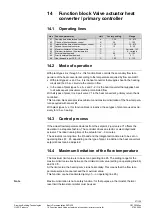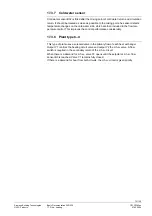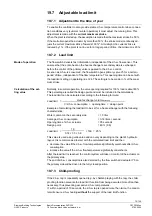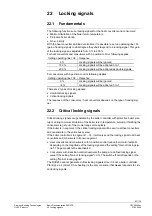
71/130
Siemens Building Technologies
Basic Documentation RVD230
CE1P2383en
HVAC Products
17 D.h.w. heating
27.05.2004
•
no heat is required for space heating,
and
•
no d.h.w. is consumed
Protection against cooling down is only active in d.h.w. heating mode (d.h.w. release
given, holiday function not active).
Adjustable on operating line 192 is the waiting time, that is, the period of time between
2 valve opening actions. The following settings are fixed:
•
Opening time: 30 seconds
•
Stroke: 25 %
•
Switch-off temperature (only if sensor is present); it lies 5 °C below the d.h.w. setpoint
With plant types 0–4, 1–4 and 5–4, the temperature for the cooling down protection is
acquired with return sensor B72 in the primary d.h.w. circuit. This means that only one
sensor is required for maximum limitation of the return temperature and the cooling
down protection. But the function can also be provided without using a sensor.
Cooling down is prevented by primary valve Y5 in the d.h.w. circuit, which opens at
regular intervals based on fixed settings. This takes place when
•
there was no demand for heat during the waiting time (neither for space heating nor for
d.h.w.)
•
waiting time since the last valve opening action has elapsed
Protection against cooling down will close the valve again:
•
Without sensor: on completion of the opening time
•
With sensor: when the return temperature is higher than the switch-off temperature, or
after 4 minutes
The function will be stopped prematurely when
•
the flow switch delivers a signal, or
•
the heating circuit or d.h.w. circuit calls for heat
If required, protection against cooling down can be deactivated (entry --- on operating
line 192).
17.3.4 Siting the sensors
Special attention must be paid to the correct location of the sensors. If no flow switch is
used, it must be made certain that the flow sensor immerses into the heat exchanger.
Caution
If the flow sensor is not correctly sited,
there is a risk of excessive heat exchanger
temperatures
. With these types of plant, d.h.w. can continually be heated, but the
circulating pump runs only when released!
17.3.5 Flow
switch
If desired, a flow switch can be fitted in the heat exchanger’s cold water return. For this
purpose, the RVD230 provides digital input H5, which is to be configured on operating
line 55.
The flow switch improves the control performance of the heat exchanger. It indicates to
the control system when a demand for heat can be expected. When there is no flow, it
is possible to ensure that the d.h.w. delivered will not be too hot.
The use of a flow switch is especially recommended in the case of smaller plants (sin-
gle-family houses, etc.).
Fault status supervision is not possible since short-circuits and open-circuits are permit-
ted statuses.
Functions that are dependent on the flow switch are the adjustable load limit (refer to
section 19.7) and the child-proofing facility (refer to subsection 19.7.3).
Prerequisites
Mode of operation















































